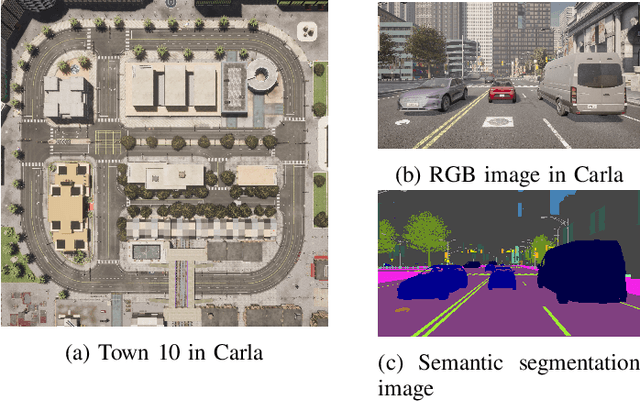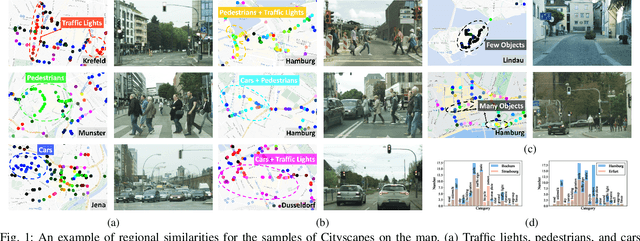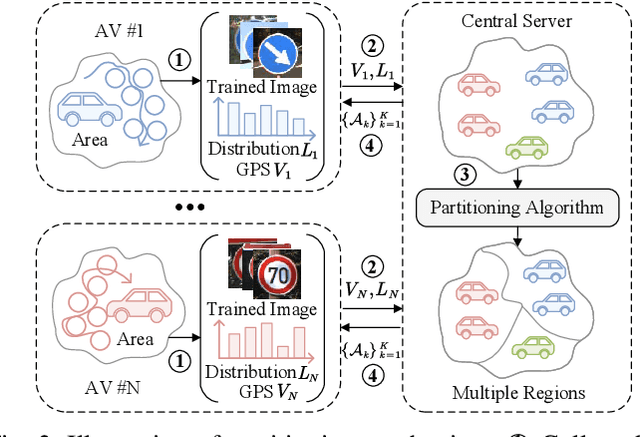Songtao Guo
FedPAW: Federated Learning with Personalized Aggregation Weights for Urban Vehicle Speed Prediction
Dec 02, 2024



Abstract:Vehicle speed prediction is crucial for intelligent transportation systems, promoting more reliable autonomous driving by accurately predicting future vehicle conditions. Due to variations in drivers' driving styles and vehicle types, speed predictions for different target vehicles may significantly differ. Existing methods may not realize personalized vehicle speed prediction while protecting drivers' data privacy. We propose a Federated learning framework with Personalized Aggregation Weights (FedPAW) to overcome these challenges. This method captures client-specific information by measuring the weighted mean squared error between the parameters of local models and global models. The server sends tailored aggregated models to clients instead of a single global model, without incurring additional computational and communication overhead for clients. To evaluate the effectiveness of FedPAW, we collected driving data in urban scenarios using the autonomous driving simulator CARLA, employing an LSTM-based Seq2Seq model with a multi-head attention mechanism to predict the future speed of target vehicles. The results demonstrate that our proposed FedPAW ranks lowest in prediction error within the time horizon of 10 seconds, with a 0.8% reduction in test MAE, compared to eleven representative benchmark baselines. The source code of FedPAW and dataset CarlaVSP are open-accessed at: https://github.com/heyuepeng/PFLlibVSP and https://pan.baidu.com/s/1qs8fxUvSPERV3C9i6pfUIw?pwd=tl3e.
FedAH: Aggregated Head for Personalized Federated Learning
Dec 02, 2024



Abstract:Recently, Federated Learning (FL) has gained popularity for its privacy-preserving and collaborative learning capabilities. Personalized Federated Learning (PFL), building upon FL, aims to address the issue of statistical heterogeneity and achieve personalization. Personalized-head-based PFL is a common and effective PFL method that splits the model into a feature extractor and a head, where the feature extractor is collaboratively trained and shared, while the head is locally trained and not shared. However, retaining the head locally, although achieving personalization, prevents the model from learning global knowledge in the head, thus affecting the performance of the personalized model. To solve this problem, we propose a novel PFL method called Federated Learning with Aggregated Head (FedAH), which initializes the head with an Aggregated Head at each iteration. The key feature of FedAH is to perform element-level aggregation between the local model head and the global model head to introduce global information from the global model head. To evaluate the effectiveness of FedAH, we conduct extensive experiments on five benchmark datasets in the fields of computer vision and natural language processing. FedAH outperforms ten state-of-the-art FL methods in terms of test accuracy by 2.87%. Additionally, FedAH maintains its advantage even in scenarios where some clients drop out unexpectedly. Our code is open-accessed at https://github.com/heyuepeng/FedAH.
FedRAV: Hierarchically Federated Region-Learning for Traffic Object Classification of Autonomous Vehicles
Nov 21, 2024



Abstract:The emerging federated learning enables distributed autonomous vehicles to train equipped deep learning models collaboratively without exposing their raw data, providing great potential for utilizing explosively growing autonomous driving data. However, considering the complicated traffic environments and driving scenarios, deploying federated learning for autonomous vehicles is inevitably challenged by non-independent and identically distributed (Non-IID) data of vehicles, which may lead to failed convergence and low training accuracy. In this paper, we propose a novel hierarchically Federated Region-learning framework of Autonomous Vehicles (FedRAV), a two-stage framework, which adaptively divides a large area containing vehicles into sub-regions based on the defined region-wise distance, and achieves personalized vehicular models and regional models. This approach ensures that the personalized vehicular model adopts the beneficial models while discarding the unprofitable ones. We validate our FedRAV framework against existing federated learning algorithms on three real-world autonomous driving datasets in various heterogeneous settings. The experiment results demonstrate that our framework outperforms those known algorithms, and improves the accuracy by at least 3.69%. The source code of FedRAV is available at: https://github.com/yjzhai-cs/FedRAV.
A Survey of Robustness and Safety of 2D and 3D Deep Learning Models Against Adversarial Attacks
Oct 01, 2023Abstract:Benefiting from the rapid development of deep learning, 2D and 3D computer vision applications are deployed in many safe-critical systems, such as autopilot and identity authentication. However, deep learning models are not trustworthy enough because of their limited robustness against adversarial attacks. The physically realizable adversarial attacks further pose fatal threats to the application and human safety. Lots of papers have emerged to investigate the robustness and safety of deep learning models against adversarial attacks. To lead to trustworthy AI, we first construct a general threat model from different perspectives and then comprehensively review the latest progress of both 2D and 3D adversarial attacks. We extend the concept of adversarial examples beyond imperceptive perturbations and collate over 170 papers to give an overview of deep learning model robustness against various adversarial attacks. To the best of our knowledge, we are the first to systematically investigate adversarial attacks for 3D models, a flourishing field applied to many real-world applications. In addition, we examine physical adversarial attacks that lead to safety violations. Last but not least, we summarize present popular topics, give insights on challenges, and shed light on future research on trustworthy AI.
Random Forests and VGG-NET: An Algorithm for the ISIC 2017 Skin Lesion Classification Challenge
Mar 15, 2017Abstract:This manuscript briefly describes an algorithm developed for the ISIC 2017 Skin Lesion Classification Competition. In this task, participants are asked to complete two independent binary image classification tasks that involve three unique diagnoses of skin lesions (melanoma, nevus, and seborrheic keratosis). In the first binary classification task, participants are asked to distinguish between (a) melanoma and (b) nevus and seborrheic keratosis. In the second binary classification task, participants are asked to distinguish between (a) seborrheic keratosis and (b) nevus and melanoma. The other phases of the competition are not considered. Our proposed algorithm consists of three steps: preprocessing, classification using VGG-NET and Random Forests, and calculation of a final score.
 Add to Chrome
Add to Chrome Add to Firefox
Add to Firefox Add to Edge
Add to Edge